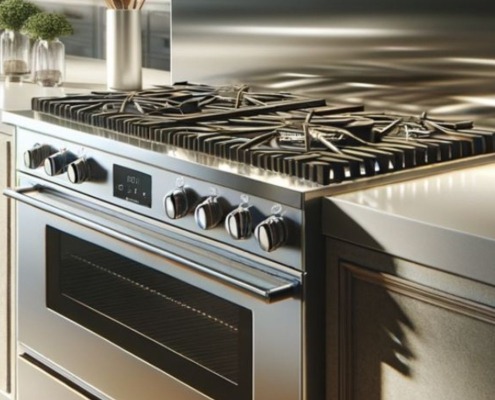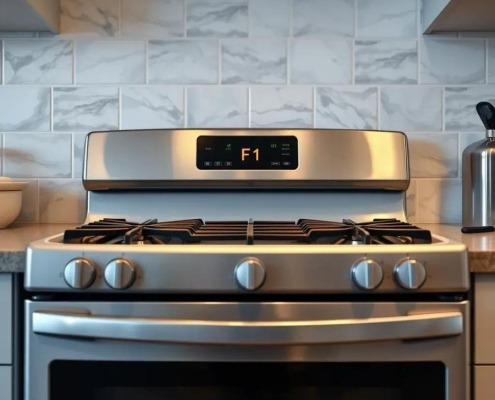Electric Range Too Hot: Top 4 Reasons and Fixes (With Video!)
APP Expert / Friday October 22, 2021
Is your electric stove turning your culinary masterpieces into a charred mess? A stove running too hot is not only frustrating but can lead to even bigger issues in your kitchen. Fear not! We’ve got a simple guide and a step-by-step how-to video below that walks you through diagnosing and fixing the four most common causes of an overheating stove, so you can get back to cooking with confidence.
Is your electric stove range running too hot? This could result in burned food and even bigger problems. There are 4 main reasons and part failures that can be to blame for an electric stove running too hot. Before working with your stove to troubleshoot, make sure to unplug your stove from power sources. Once your stove is ready to work with, follow this easy guide to determine which of the four reasons may be to blame and fix your stove yourself.
Once you have identified the part needed for your stove, search below using your range model number to identify the exact part needed:
1. Air Flow
If the oven is not getting enough proper air flow, that could impact its ability to operate properly. This could cause heat buildup in the oven, so be sure that all of the vents are open and not blocked or covered by anything, whether you’re using the oven or not. If they are blocked or filled with debris, clean everything really well to ensure optimal air flow.
2. Oven Temperature Sensor
Modern electric ranges, the temperature sensor is located inside of the oven, and is responsible for signaling to the electronic controls to turn the elements on or off, based on the temperature desired and the current temperature of the oven. If the sensor isn’t working or somehow becomes damaged, it may be the cause of the oven getting little to no heat.
The temperature sensor is typically located inside the oven near the heating element. Make sure that you unplug your oven so that you prevent the risk of electric shock. Then, open the oven door and locate the sensor. Check the back wall near the top, but it may be located elsewhere, too. Make sure that the sensor is removed carefully and allow it to reach room temperature.
Then, you can use your multimeter to test the sensor. Using the Rx1 setting, you should touch the probes to the terminals of the sensor so that you can test the continuity of the part. The amount of resistance is going to vary from one model to the next, so check your owner’s manual to see what kind of reading you should expect. In the event the reading does not match, you may need to invest in a replacement sensor.
3. Oven Control Board
Modern range ovens have a control panel and an electronic control board that tells all of the different parts how to work, when to work, and what they need to do. If this control board is not working properly, it cannot tell the elements how hot to get, or the thermostat when to shut off the elements, and so forth. This is usually the last thing to check because there isn’t really a way to test it beyond a visual inspection.
You should unplug the range and then locate the control board, which is typically behind the control panel. You may have to remove the back panel of the range to find it. Once you locate the board, check for damage and loose connections, and then remove it. Perform a closer visual inspection, looking for burn marks, cracks, or other signs of potential damage. If nothing is visible but none of the other solutions have worked, this may be the solution.
4. Oven Thermostat
There is a thermostat in every oven that is responsible for controlling the broil and bake functions. The switch is temperature-controlled, and has contacts that will supply the power to ensure that the elements work as they should. If the thermostat were to malfunction, it could cause the oven to produce too much heat and burn your food or simply be unreliable for cooking.
You can check this easily using a multimeter, but you will want to disconnect the power from the appliance before you start. Once the range is unplugged, you will need to remove the back panel and locate the thermostat, which can usually be found around the control panel, or perhaps even on the electronic control board.
Remove the thermostat from the oven and use the multimeter to test the terminals. Your owner’s manual wiring diagram will tell you which terminals to test and what types of readings you should anticipate. If anything doesn’t match or measure up, it may be a sign that it needs replaced.
Where To Find Us
If you need any replacement parts for your appliances, you can enter your model number at AppliancePartsPros.com to locate and order them quickly. Most orders arrive in just two business days, and we have tons of great information in our repair help section and YouTube videos to help you troubleshoot.
Stay connected with the latest DIY tips, tutorial videos, and repair guides by following us on Facebook, Instagram, and Twitter. We love hearing about your repair stories and successes. If you need more help or want personalized guidance, feel free to contact or call us at 877-477-7278. We’re ready to help you take on your next project with confidence!
Since 1999, AppliancePartsPros.com has helped millions of people repair their broken appliances by providing high-quality original parts at well below retail prices, free support and troubleshooting, and award-winning customer service from an expert, friendly, US-based customer support team!
Hi! I’m Matt H., and I’m thrilled to be your guide through the world of appliance repair with over 25 years of invaluable experience in the industry.
From the early days of my career, I have been deeply passionate about appliances and their inner workings. Over the years, I’ve seen it all – from vintage models to the latest cutting-edge technology – and I’ve dedicated myself to mastering the art of repair. With a toolbox in one hand and a wealth of knowledge in the other, I’ve tackled every challenge that has come my way, learning and growing with each repair.
Join me as we dive into the intricacies of appliance repair. From step-by-step repair guides to explanations of common problems and their solutions, I’ll be here to simplify the repair process and empower you with the knowledge you need to keep your appliances running smoothly.
Feel free to explore our blog, ask questions, and leave comments – this platform is a space for learning, sharing, and growing together. Let’s work together to ensure that your appliances continue to serve you for years to come.
Thank you for joining me on this journey, and I look forward to being your go-to resource for all things related to appliance repair!





